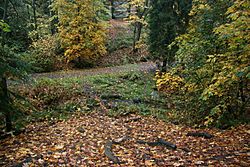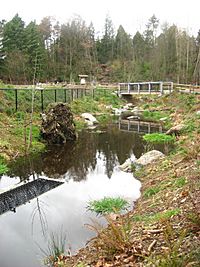Ravenna Park facts for kids
Ravenna Park and Cowen Park are two parks right next to each other in the Ravenna neighborhood of Seattle, Washington, United States. These public parks include a deep valley, called a ravine, which is about 115 feet (35 meters) deep. A stream called Ravenna Creek flows through this valley.
Park History
The deep valley you see in Cowen and Ravenna Park was created a very long time ago. It happened when a huge sheet of ice, called the Vashon Glacial Ice Sheet, melted. This meltwater formed a big lake called Lake Russell. As the water flowed, it carved out deep ravines through the new dirt and rocks left by the glacier.
Lake Russell disappeared when the ice sheet moved north. But some parts of the landscape remained, like the area where Green Lake is today. Water from this area continued to flow through the Ravenna ravine into Lake Washington. Over time, deeper spots in the basin became lakes like Bitter Lake, Haller Lake, and Green Lake. Many small streams and springs fed into Green Lake, and its water then flowed out through the Ravenna ravine, creating Cowen and Ravenna parks.
Originally, Ravenna Creek got its water from Green, Haller, and Bitter lakes. Later, between 1908 and 1948, the water flow was changed to go into sewers. Now, the creek's water mostly comes from underground water seeping out of the west wall of the ravine in Cowen Park. The entrance to Cowen Park has a special message: "In memory of Charles Cowen, who in 1906 gave to the City of Seattle the twelve acres comprising this park." Charles Cowen donated 12 acres (about 4.9 hectares) of land to the city for the park.
For many years, the Ravenna Park ravine was left untouched by loggers and farmers. It still had huge, very old trees, some nearly 400 feet (122 meters) tall! These trees were even shown off at the Alaska-Yukon-Pacific Exposition in 1909. Sadly, these giant trees slowly disappeared by 1926. Today, no trees of that size exist anywhere in the world.
In 1919, after President Theodore Roosevelt passed away, the city changed the park's name to "Roosevelt Park." However, people in Seattle asked to change it back to the original name in 1931, and they did.
In the mid-1960s, a large part of the Cowen Park ravine was filled in with dirt from freeway construction. In 1986, the city planned to use the ravine for a big stormwater pipe project. This made the local neighborhoods want to protect and restore the park. Since 1991, people living nearby have worked with the city to make big improvements to the park.
Park Features

Ravenna Park is about 49.9 acres (20.2 hectares) in size and was bought by the city in 1911. Cowen Park is smaller, covering about 8.4 acres (3.4 hectares). Today, Ravenna Creek gets its water from the west side of the ravine along Brooklyn Avenue NE and a small wet area in the northwest corner, near NE 62nd Street. In 2006, a part of Ravenna Creek that used to flow into a storm drain was brought back to the surface. This is called "daylighting" a stream.
Two bridges cross the parks from north to south. The Cowen Park Bridge is on 15th Avenue Northeast, right between the two parks. The 20th Avenue Northeast Bridge, also known as the Ravenna Park Bridge, has been closed to cars since 1975. Both of these bridges are listed on the National Register of Historic Places because they are important historical structures. There's also a walking and biking path along the southern edge of the park where an old streetcar line used to run.
What to Do in Ravenna Park
Ravenna Park is a wooded valley about half a mile (0.8 kilometers) long. It connects two picnic areas just north of the University District. The park is a great place for people who enjoy hiking, jogging, biking, and having picnics. It also has a fun play area for children, a wading pool for hot days, a ballfield for games, and tennis courts.
Park Plants
The parks are mostly covered with trees native to the area. These include Bigleaf Maple, Douglas Fir, Grand Fir, Western Hemlock, Western White Pine, and Western Redcedar. You can also find some non-native trees like Coast Redwood, Incense-cedar, and Western Larch.
The Seattle Parks Department often holds work parties in the park, especially in April and May. A group of volunteers called "Friends of Ravenna Ravine" also works hard to remove plants that don't belong there, like English Ivy and Himalayan Blackberry. They help bring back the native plants that should be growing in the park.
Images for kids





